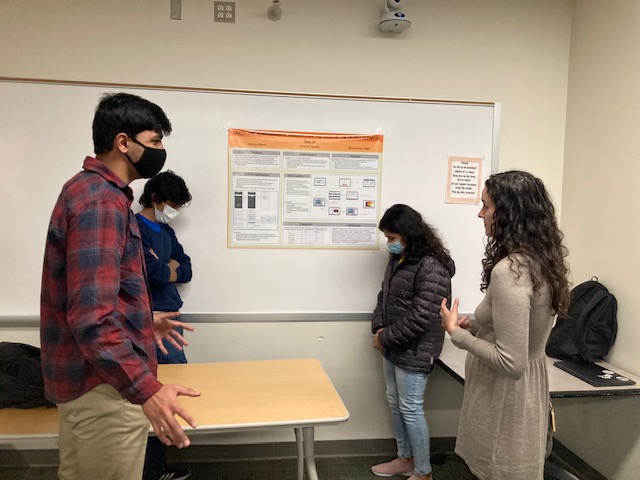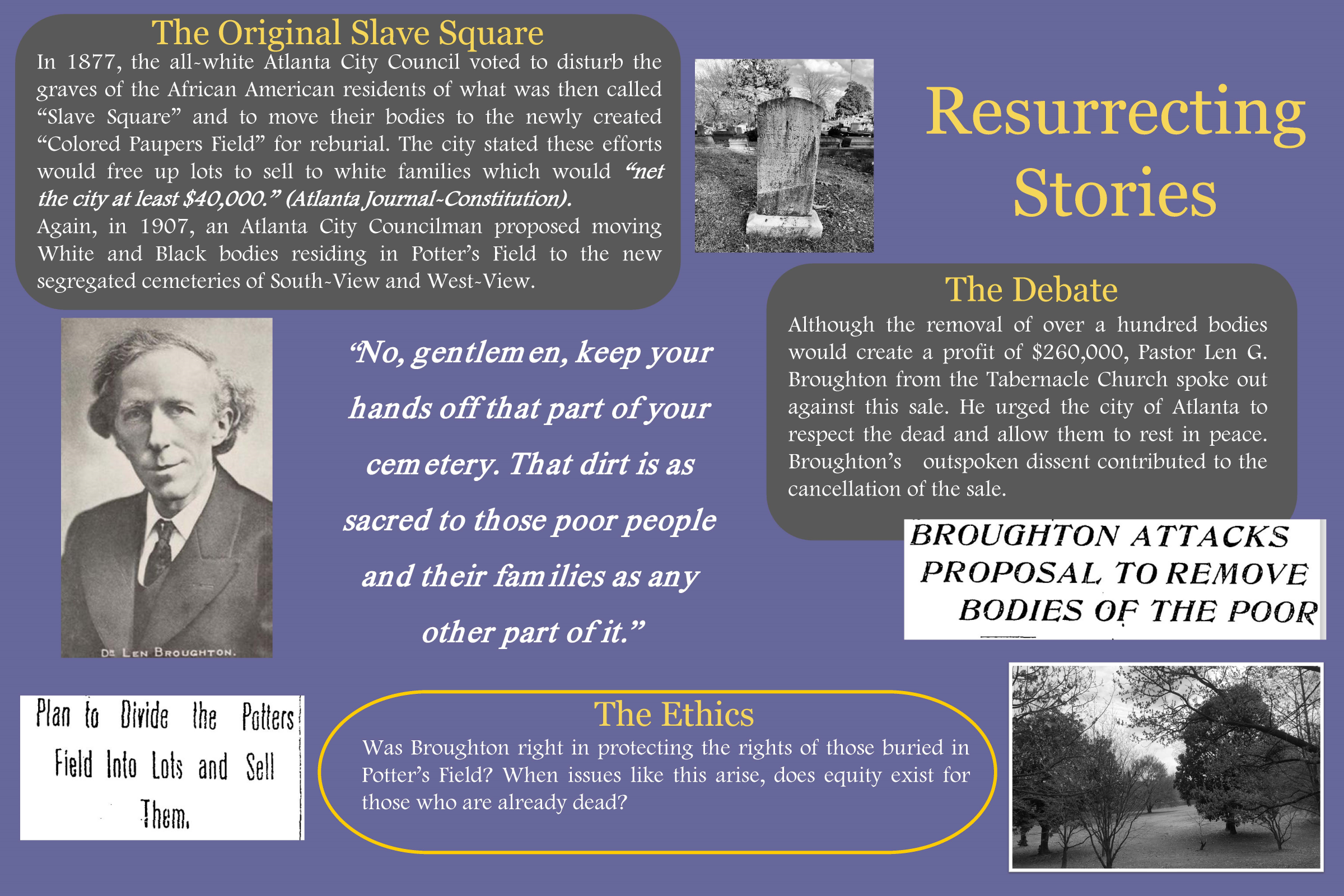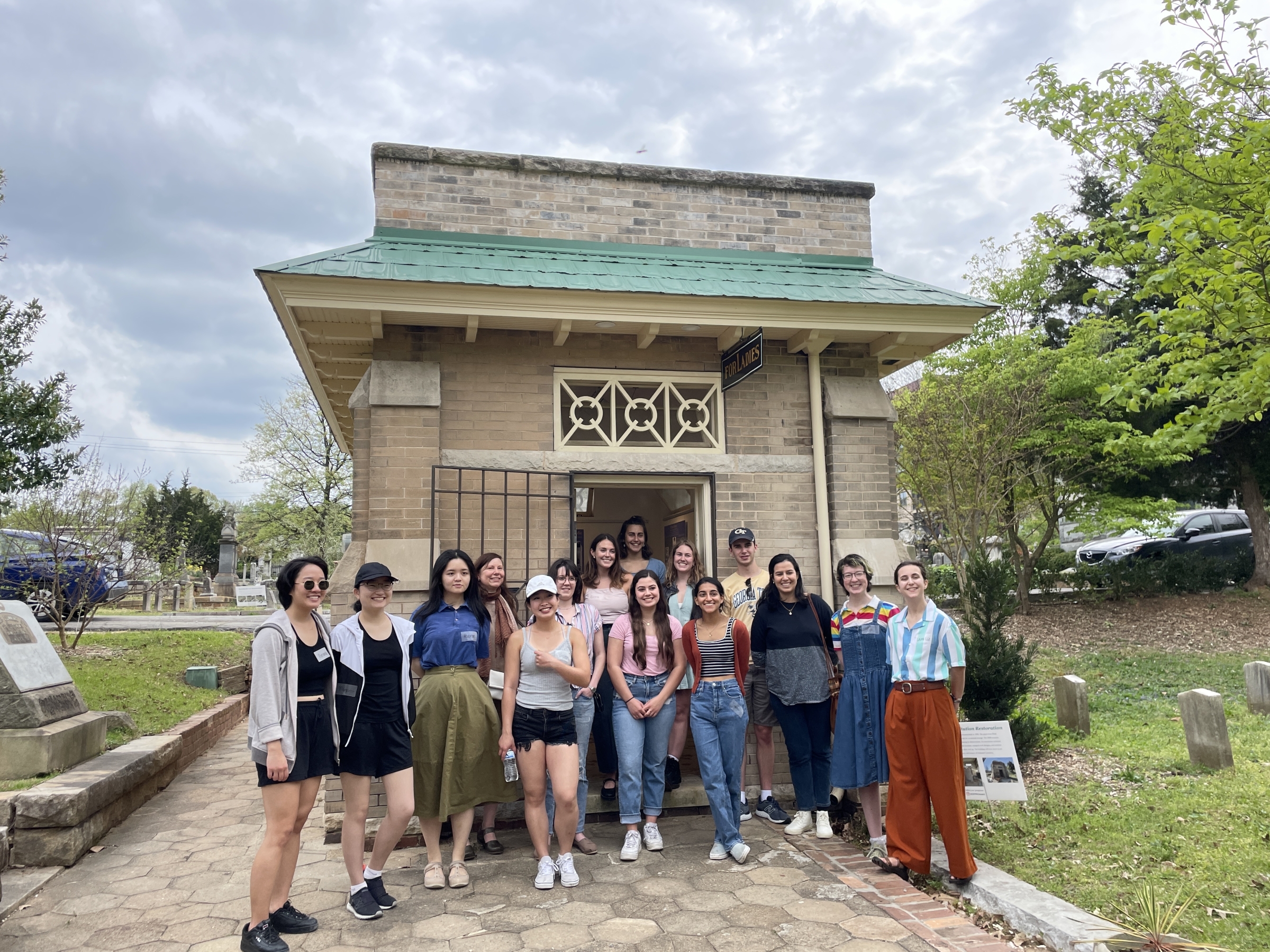The partnerships that SLS staff support between Georgia Tech faculty and community-based organizations get started in a variety of ways. Sometimes, a faculty member gets in touch with us about a great idea for a partnership, requesting some help identifying the right match. At other times, community-based groups find SLS through networks of sustainability and equity professionals such as the RCE Greater Atlanta. About a year ago, we were fortunate to have a new partner find us thanks to the recommendation of our friends at Park Pride. Mary Fernandez, Director of Special Events, Special Projects & Volunteers with Historic Oakland Foundation, reached out to SLS to see if we might help her identify faculty or students at Georgia Tech who could help the historic cemetery better understand and serve the diverse kinds of visitors that enjoy this fascinating park every day. Together, we developed several research questions and then reached out to faculty whose courses might align. Historic Oakland Foundation’s questions included:
- How can we more effectively assess who we are serving, so that we can serve them better--and identify and engage groups we may be missing?
- What kinds of guest data collection options might work well at Oakland Cemetery?
- How might Oakland Cemetery track the ways in which visitors use the park?
Park Pride’s suggestion of SLS and Mary’s inquiry ultimately resulted in a highly creative, interdisciplinary partnership in collaboration with Rosa Arriaga, Associate Chair for Graduate Affairs and Associate Professor in the School of Interactive Computing, and Carla Gerona, Associate Professor of History. Rosa, Carla, and Mary share their experiences, below.
Rosa Arriaga shares:
 Human Computer Interaction (HCI) is the subdiscipline in Computer Science that is tasked with designing computational artefacts that are useful and useable. I teach both an undergraduate (3790/3873) and a graduate (6750) introductory HCI course. These courses include semester-long group projects where students employ the four-phased User-Centered Design approach (requirements gathering, or understanding the user and the context, ideation, prototyping and evaluation). Over the years I have found that the various activities in this class are more engaging to students if we have a “real target user.” In the past our class has worked with the Jimmy Carter Presidential Center, the Atlanta Beltline, Atlanta Community Food Bank and various United Way Partners.
Human Computer Interaction (HCI) is the subdiscipline in Computer Science that is tasked with designing computational artefacts that are useful and useable. I teach both an undergraduate (3790/3873) and a graduate (6750) introductory HCI course. These courses include semester-long group projects where students employ the four-phased User-Centered Design approach (requirements gathering, or understanding the user and the context, ideation, prototyping and evaluation). Over the years I have found that the various activities in this class are more engaging to students if we have a “real target user.” In the past our class has worked with the Jimmy Carter Presidential Center, the Atlanta Beltline, Atlanta Community Food Bank and various United Way Partners.
Having partnered with SLS in the past, I jumped at the chance to work with the Historic Oakland Cemetery. The first job for me is to develop a “design theme.” This term it was “Death and Remembrance: Digital Artifacts to Celebrate the Life of the Dearly Departed.” Students were able to conduct literature reviews to understand how other HCI researchers had broached this theme. They then conducted research activities of their own (surveys, interviews, competitive analyses, etc.) to better understand the design space. From there they developed innovative designs (presented during a poster session) to meet their target users’ needs. Eventually the students built a prototype of their computational artefact and evaluated it. This year, students from Dr. Gerona’s class, SLS staff and Mary Fernandez all provided feedback to the project teams. Students were also able to go to the Oakland Cemetery at various times during the semester.
Three projects that resulted:
- Team Held: Designed a mobile phone-based application to allow visitors to the Oakland Cemetery to easily navigate it and learn about various points of interest as well as get answers to their questions. Further, the app has features that are optimized for individuals with visual and physical impairments.
- Team Good Grief: Designed a physical device to facilitate personal-reflection and self-expression during the grieving process.
- Team Commemor8: Designed an augmented reality (AR) based system to create and share digital artifacts for commemorating the dearly departed. Individuals would be able to create shrines for the dearly departed and “visitors” could add tokens (i.e., pictures, audio, text).
Carla Gerona shares:
 HTS 3100, “Introduction to Museum Studies,” is an undergraduate studio history class, in which students learn about public history and museums by researching, doing, and creating. The class contributes to Georgia Tech’s General Education curriculum, focusing on communication, teamwork, and critical thinking. Students in this course gain insight into history and museum studies through the completion of public exhibits in coordination with various partners including, The Robert C. Williams Paper Museum, The Georgia Tech Archives, The Bobby Jones Golf Club, and now, the Oakland Cemetery and Georgia Tech’s Serve-Learn-Sustain Center. Like the Human Computer Interaction course, “Introduction to Museum Studies” also focuses on creating useful spaces for communities, and, especially, designing places to contemplate and learn about the past beyond a classroom. Like Dr. Arriaga, I was thrilled with this opportunity to work with these new partners. SLS’s focus on community-engaged learning and Oakland Cemetery’s mission to preserve and share Atlanta’s most complex historic artifact aligned perfectly with the “Introduction to Museum Studies” class goals.
HTS 3100, “Introduction to Museum Studies,” is an undergraduate studio history class, in which students learn about public history and museums by researching, doing, and creating. The class contributes to Georgia Tech’s General Education curriculum, focusing on communication, teamwork, and critical thinking. Students in this course gain insight into history and museum studies through the completion of public exhibits in coordination with various partners including, The Robert C. Williams Paper Museum, The Georgia Tech Archives, The Bobby Jones Golf Club, and now, the Oakland Cemetery and Georgia Tech’s Serve-Learn-Sustain Center. Like the Human Computer Interaction course, “Introduction to Museum Studies” also focuses on creating useful spaces for communities, and, especially, designing places to contemplate and learn about the past beyond a classroom. Like Dr. Arriaga, I was thrilled with this opportunity to work with these new partners. SLS’s focus on community-engaged learning and Oakland Cemetery’s mission to preserve and share Atlanta’s most complex historic artifact aligned perfectly with the “Introduction to Museum Studies” class goals.
This partnership provided the students with an opportunity to curate their exhibit, “Tales From the Other Side: Oakland Cemetery from the 1850s to the 1930s,” on site at Oakland Cemetery. Atlanta’s history has deep roots in slavery and the Jim Crow South, as well as being the home to thriving black communities such as Sweet Auburn. A central goal of the class was to explore how different people experienced Atlanta in varying ways, even in matters relating to death. While other Atlanta cemeteries interred Black or White people exclusively, Oakland included burials from both groups, as well as Atlanta’s immigrant and Jewish community, thus providing a rich canvas to explore Atlanta’s historical and racial complexities. As students conducted research in newspapers, journals, the Atlanta History Center and genealogical collections, they unearthed intriguing stories that shed light on the struggles, tragedies, and accomplishments that marked Atlanta’s history. In addition to the exhibit at the Oakland Cemetery “Women’s Comfort Station,” students created podcasts and individual panels to display in Georgia Tech’s Old CE Computer Lab Gallery and the Southern Trails Digital Space. Sharing feedback with Dr. Arriaga’s class, Ms. Fernandez, and the SLS team provided students with an invaluable real-world experience as they made new connections with each other and across place and time.
Mary Fernandez shares:
 Historic Oakland Foundation’s mission is to preserve, restore, enhance, and share historic Oakland Cemetery in partnership with the City of Atlanta. Our work with students at the Georgia Institute of Technology through the Center for Serve-Learn-Sustain has contributed to our work of fulfilling that final and critical point in our mission—the sharing of Oakland and its history. Whether focusing on the stories that can be found among the flowers and headstones of Oakland’s hardscape and landscape or focusing on how visitors to the cemetery can best access all that the cemetery has to offer, our partnership was an incredibly enriching and fruitful one that has had a meaningful impact on our guests already. The historic site welcomes hundreds of visitors daily who have had the opportunity to learn from Dr. Carla Gerona’s students’ exhibition in our historic Women’s Comfort Station building, “Tales from the Other Side: Oakland Cemetery from the 1850s-1930s.” Additionally, as the Foundation grows and expands, we’ve been offered models on how to engage with visitors using accessible technology through the work conducted by students under the direction of Dr. Rosa Arriaga. All these projects were completed with a focus on diversity, equity, inclusion, and access—ensuring that Oakland Cemetery remains a place that is both of and for the communities it serves.
Historic Oakland Foundation’s mission is to preserve, restore, enhance, and share historic Oakland Cemetery in partnership with the City of Atlanta. Our work with students at the Georgia Institute of Technology through the Center for Serve-Learn-Sustain has contributed to our work of fulfilling that final and critical point in our mission—the sharing of Oakland and its history. Whether focusing on the stories that can be found among the flowers and headstones of Oakland’s hardscape and landscape or focusing on how visitors to the cemetery can best access all that the cemetery has to offer, our partnership was an incredibly enriching and fruitful one that has had a meaningful impact on our guests already. The historic site welcomes hundreds of visitors daily who have had the opportunity to learn from Dr. Carla Gerona’s students’ exhibition in our historic Women’s Comfort Station building, “Tales from the Other Side: Oakland Cemetery from the 1850s-1930s.” Additionally, as the Foundation grows and expands, we’ve been offered models on how to engage with visitors using accessible technology through the work conducted by students under the direction of Dr. Rosa Arriaga. All these projects were completed with a focus on diversity, equity, inclusion, and access—ensuring that Oakland Cemetery remains a place that is both of and for the communities it serves.